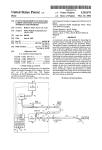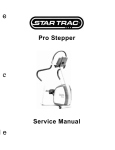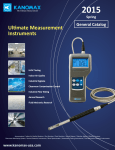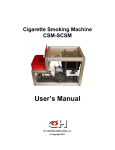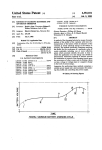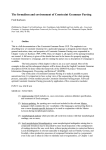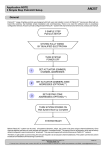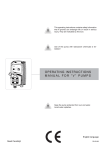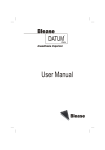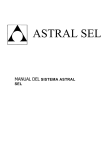Download @?igllalgiill —
Transcript
US00540488SA United States Patent [191 [11] [45] Sheehan et a1. [54] FILTER UNIT FOR END-TIDAL CARBON [75] Inventors: Neil J. Sheehan, Palo Alto; Scott R. Rouw, Union City; Robert T. Stone, Sunnyvale, all of Calif. Natus Medical, Incorporated, San Carlos, Calif. ‘ Product Literature-KNF Diaphragm Micro Pump Type NMP 02 (2 pages). Primary Examiner-—Lee S. Cohen Assistant Examiner-Robert L. Nasser, Jr. Attorney, Agent, or Firm—Davis, Hoxie, Faithfull & ABSTRACT A noninvasive device and methods for measuring the end-tidal carbon monoxide concentration in a patient’s breath, particularly newborn and premature infants. Division of Ser. No. 990,425, Dec. 15, 1992, aban The patient’s breath is monitored. An average carbon doned, which is a continuation-in-part of Ser. No. monoxide concentration is determined based on an av 899,261, Jun. 16, 1992, Pat. No. 5,293,875. [51] red Transducer brochure (2 pages) and technical note (9 [57] Jan. 21, 1994 Related US. Application Data [60] Apr. 11, 1995 Hapgood [21] Appl. No.: 184,379 [22] Filed: 5,404,885 pages). MONOXIDE MONITOR [73] Assignee: Patent Number: Date of Patent: erage of discrete samples in a given time period. The Int. 01.6 .............................................. .. A61B 5/08 [52] US. Cl. .................................. ..128/716;128/719; 128/204.22; 422/83; 73/233 [58] Field of Search ................. .. 128/716, 719, 204.22, [56] 128/204.23, 205.22; 422/83, 84; 73/233 References Cited U.S. PATENT DOCUMENTS 3,977,394 8/1976 Jones et al. ...................... .. 128/2.07 4,304,578 12/1981 Hakala et a1. 128/719 4,423,739 l/l984 128/719 4,821,737 4/1989 .. 4,831,024 5/ 1989 4,870,961 10/1989 4,886,528 11/1989 4,968,887 5,003,985 ll/ 4/1991 1990 White et al. .................. .. 364/4l3.03 OTHER PUBLICATIONS ratio of the end-tidal portion of the breath ?ow sample ' is separately determined, preferably based on monitor ing the level of carbon dioxide in the gas sample and identifying the carbon dioxide concentration levels cor responding to the end-tidal portion of the breath sam ple. The sensed carbon monoxide level is converted to the end-tidal carbon monoxide level by subtracting the ambient carbon monoxide level and dividing the re mainder by the ratio of end-tidal breath to breath in the breath sample. An easy to use microcontroller-based device containing a carbon dioxide detector, a carbon monoxide detect and a pump for use in a hospital, home, physician’s of?ce or clinic by persons not requiring high skill and training is described. A replaceable ?lter unit made of a single tri-lumen PVC extrusion and a tube segment inter-connecting two of the lumens used to provide the consumable ?ltration material. The ?ltra tion material is interposed between the carbon dioxide sensor and the carbon monoxide sensor which are Yeung et 211., “Automatic End Expiratory Air Sampling Device For Breath Hydrogen Test In Infan ”, The Lancet, vol. 337, pp. 90-93 (Jan. 12, 1991). Product Literature—Z World Engineering Little Giant Miniature Microcontroller (One page). mounted inside the monitor housing. The ?lter unit also interfaces the canula for receiving the patient’s breath sample and a hydrophobic ?lter between the patient and the carbon dioxide monitor. Product Literature-Servomex Mode 1505 C02 Infra 16 Claims, 11 Drawing Sheets 002 nonnoa @?igllalgiill — ~~ -- -- - - I. 5- I... -‘II‘JF'.’ I. US. Patent Apr. 11, 1995 Sheet 1 of 11 M@5E2:3 %E5mm5E5 \no?‘ 21 2 5,404,885 US. Patent Apr. 11, 1995 Sheet 3 of 11 5,404,885 W2 :2 .28. AI_ E5:50E2 ‘N@2\:|x2"3\ 2-\. 1v :2:2 : I J:EI23 /(o:52555ageN3s:. .‘ 252: S E 5 6 a : t 5 : 2 8 5 1 : ? ‘52\:.57s.2Z%2:I2 %;: :2.5$025:.2 2E5: :22EE:N28.2o52n?.5 _.E2Q5_3z§2.%_é ~ ~_3.2;: a:E5E:2 .“%;E. E$2:252%m2:8z35%E23. 0A.‘ ‘ 5 2E:2%2:<251:2:. 2.523g8%30: E2.23Z:52E;O. y‘5.21.2: loM__5,3E:25 s2:5 2E.:532 ;? 125:3 .:2.5522a5g2e%: US. Patent E@9593 r...r50 A E2g53.%» Apr. 11, 1995 82o: Sheet 8 0f 11 5,404,885 US. Patent Apr. 11, 1995 Sheet 9 0f 11 5,404,885 1.25 0.50 V00 _ 000i 025 *2 FIG. 34 "ME-- 0 L25. 0.50 0.00 NWWUMM/UUUUUUUUU ‘0' TlME-—-—~ _ F/ 6. 3B 002 0000000010100 0R 0 EQUIVALENT 002 SENSOR RESPONSE 002 = $02 MEAN DC ‘ DUTY CYCLE w ?k_ _/£1U(:\__ (20 , - Flat 45 B U.S. Patent Apr. 11, 1995 Sheet 10 of 11 5,404,885 US. Patent ‘hE 5E Apr. 11, 1995 Sheet 11 of 11 5,404,885 ?’ H. u . . . r. “H. .H .“ H". .i.:f ... .1.. a \ ¢ I 1 \ New 1 5,404,885 FILTER UNIT FOR END-TIDAL CARBON MONOXIDE MONITOR 2 ment to analyze the acquired sample. In addition, this technique requires time and personnel to transport the sample from the patient to the laboratory (or equip ment) where the analysis is conducted, and then to CROSS REFERENCE TO RELATED 5 report back to the attending physician/practitioner for a APPLICATIONS diagnosis and prescription, if any. Another problem with this technique is that accurate This is a divisional of U.S. Pat. application No. assessment of the concentration difference in carbon 07/990,425, ?led Dec. 15, 1992, now abandoned, which is a continuation-in-part of U.S. Pat. application 07/899,26l, ?led Jun. 16, 1992, now U.S. Pat. No. monoxide requires obtaining good samples of end-tidal patient breath. This essentially requires that the patient 5,293,875. have a regular, predictable breathing cycle. Thus, it can be dif?cult to obtain a good sample by watching chest FIELD OF THE INVENTION wall movement, particularly for a newborn and for This invention relates to methods and apparatus for patients having irregular breathing cycles. invivo, real time measurement of end-tidal carbon mon 15 Chemical electrochemical sensors capable of measur oxide concentration in the exhaled breath, more partic ing carbon monoxide concentrations in the range of ularly to a ?lter unit for use in the determination of interest, 0 to 500 parts per million (ppm), are commer end-tidal carbon monoxide concentration in the breath cially available, e.g., model DragerSensor CO available of a newborn infant. BACKGROUND OF THE INVENTION In most animal systems, carbon monoxide is a waste from Dragerwerk, Lubeck, Germany. However, such sensors are sensitive to many other gases as well as carbon monoxide, and are therefore susceptible to er ror. Another problem with such sensors is that the mea product produced in the breakdown of free hemoglobin surement dynamics of the sample gas transport through within the blood. Ordinarily, hemoglobin is contained the gas permeable membrane and oxidation-reduction in within red blood cells and is stable. However, aging of 25 the electrochemical cell results in a relatively slow red blood cells and certain disease processes produce response time such that discrete samples of the end-tidal hemolysis, i.e., the breakdown of the cell wall. This breath must be obtained and analyzed to determine the produces free hemoglobin which breaks down in the end-tidal carbon monoxide concentration. blood. The carbon monoxide that is produced by the breakdown of free hemoglobin is normally excreted in 30 SUMMARY OF THE INVENTION the breath. When the system is in equilibrium, the carbon monox ide concentration in the breath is proportional to the difference in the concentration of carbon monoxide in It is, therefore, an object of the present invention to provide improved non-invasive apparatus and methods for measuring carbon monoxide concentration in the the blood and the concentration of carbon monoxide in 35 end-tidal breath. It is another object to provide appara tus and methods that operate in real-time. It is another room air. This difference in concentration is propor object to provide apparatus and methods for use in tional to the rate of hemolysis in the blood. determining the rate of hemolysis from the concentra The concentration of carbon monoxide in the end tion of end-tidal carbon monoxide. tidal breath, i.e., the gas that is last expelled each breath, It is another object of the present invention to pro is presumed to be at equilibrium with the concentration vide apparatus and methods for measuring end-tidal in the blood. This is because the end-tidal breath con carbon monoxide that do not require a highly skilled, tains predominantly, if not exclusively, the gas expelled trained individual to obtain and determine the measure. from the alveoli in the lungs, which gas was within the It is another object to provide such apparatus and meth alveoli for a time generally suf?cient to equilibrate with ods that do not require incrementally acquiring samples the blood. It is known that hemolysis and the resulting by of end-tidal breath during successive respiratory cycles. products and consequences of hemolysis can be esti It is another object of the invention to provide a portable, easy-to-use apparatus that can be used in a nursery, a physician’s of?ce, a hospital, a clinic, and a mated or predicted from a measure of the concentration of carbon monoxide in the end-tidal breath. See Smith, D. W. et al., “Neonatal Bilirubin Production Estimated 50 mobile clinic for measuring end-tidal carbon monoxide in real-time, for assessing the likelihood of elevated from End-Tidal Carbon Monoxide Concentration”, levels of hemolysis for immediate entry on the patient’s Journal of Pediatric Gastroenterology and Nutrition, record and prescription of an appropriate remedy. 3:77-80, 1984. It is another object of this invention to provide an One method of analysis previously reported includes incrementally acquiring a sample of end-tidal breath 55 end-tidal carbon monoxide monitor with a replaceable ?lter unit for use with different patients, and for replac and analyzing the acquired sample by mass spectros copy or gas chromatography to determine the end-tidal ing consumed gas ?ltering components. It is another carbon monoxide concentration. The sample is obtained object to provide an inexpensive disposable ?lter unit. by extracting from each of several successive breaths a It is another object of this invention to provide keyed portion of the apparent end-tidal breath using a syringe. bulkhead ?ttings on the monitor for receiving the ?lter The end-tidal portion of breath is determined by observ in the correct orientation and to provide for proper ing the chest movements of the infant. See, e.g., Vreman ?ow path interconnection and operation of the dispos able ?lter in the monitor. et a1. U.S. Pat. No. 4,831,024. One problem with this technique is that it requires a In accordance with this invention, there is provided skilled, trained user to obtain the end-tidal sample in 65 an apparatus, sampling methods, and analysis tech successive increments based on watching chest wall niques for measuring the concentration of end-tidal movements. It also requires a trained, skilled person to carbon monoxide in breath, particularly in newborn and operate a complex piece of analytical laboratory equip premature infants. Broadly, the invention concerns de 3 5,404,885 termining the concentration of end-tidal carbon monox 4 sampled at the patient into the monitor, more speci? cally, from the nasal canula to the carbon dioxide detec tor. The second ?ow path contains the consumable ?ltration medium and provides a ?ow path between the ide based on a measure of the room air carbon monoxide concentration, a measure of the average carbon monox ide concentration for a breath sample over a period of time, and a determined ratio of the end-tidal breath to 5 carbon dioxide sensor and the carbon monoxide sensor. inspired air for the sampled portion. In a preferred embodiment, the assembly is formed of a body having three flow paths (also called lumens) The present invention is based in part on the discov ery that accurate assessment of end-tidal carbon monox ide concentration may be obtained based on knowledge extending from one end to the other and a tube segment that is used to connect two of the ?ow paths at one end of the fraction of the gas sample that is end-tidal gas. 0 of the body. The consumable filtration medium is lo Thus, the present invention is able to avoid selectively sampling small samples of end-tidal breath over succes cated in one of the two lumens connected by the tube sive respiratory cycles to obtain a suf?ciently large end-tidal breath sample, which incremental sampling is path from the carbon dioxide detector, through the segment. Thus, the tube segment provides for a gas ?ow consumable ?ltration medium, and to the carbon mon problematic. Further, the invention advantageously oxide detector. Preferably, the three lumens are straight uses a conventional carbon monoxide detector, which and have longitudinal axes that are in the same plane. has a response time that is not fast enough to distinguish carbon monoxide in end-tidal breath from carbon mon oxide in inspired air, to derive the end-tidal carbon monoxide concentration in real-time. More particularly, More preferably, the three lumens have different inte rior dimensions and respectively mate to corresponding differently sized bulkhead ?ttings on the monitor. This ensures that the ?lter unit will be installed in the correct a conventional carbon monoxide detector can be used to obtain the average carbon monoxide concentration orientation with tight interconnections. In the preferred embodiment, the body and its lumens are formed by coextrusion of a single piece of plastic material, e.g., soft polyvinyl chloride. The consumable level during breathing, which average value can be related to the end-tidal value based on the determined ratio of end-tidal to inspired breath. Preferably, the 25 ?ltration medium is then inserted in one of the lumens of the second flow path. A plug is inserted into the distal most common interfering substances from a sampled breath are removed from the sample by a consumable ?ltration medium so that these substances do not affect the measurement. The present invention also applies to gas components of exhaled breath other than carbon end of that lumen, which has a ?ow passageway extend ing through the plug for receiving a length of the tube segment. The piece of tubing is bent into a U-shape to intercon nect the two selected lumens. In this regard, the tube segment preferably has an outer diameter that provides monoxide, which gas components cannot be directly monitored because of the slow response time of avail able gas detectors. an air tight frictional ?t- when it is inserted in the plug One aspect of the present invention concerns using a second gas component of the breath, other than the ?rst flow passageway and the other lumen of the second gas component whose concentration is being moni its length to minimize the likelihood of the tube collaps ing or pinching closed when it inserted in the paths. The tube segment is preferably secured to each of the plug ?ow passageway and the other lumen, which are of ?ow path. Preferably, the tubing has interior ribs along tored, to determine the ratio of the end-tidal breath to inspired air. The relative concentration level of the second gas during respiration is monitored and the ratio or duty cycle of the end-tidal portion of the sensed 40 about the same inner dimension (diameter), by a con concentration waveform relative to the inspired air is ventional solvent dipping and bonding process. determined. A sensor for detecting the level (or concen Another aspect of the invention is directed to provid tration) of the second gas having a time response that is ing a hydrophobic ?lter that plugs into the distal end of fast enough to distinguish the end-tidal breath concen the lumen of the ?lter unit forming the ?rst ?ow path. tration from the inspired air is preferably used. One 45 A conventional ?tting for receiving the hydrophobic suitable gas component is carbon dioxide, which has a ?lter is interposed between the canula tubing that is large, distinctive change in concentration with breath used to take the breath sample from the patient and the ing. Other gases may be used, e.g., hydrogen, oxygen, ?lter unit. This construction is particularly advanta or some combination of gases, e.g., carbon dioxide and geous because the ?lter and ?tting elements are quickly hydrogen. and easily assembled by the end user, and alternately The determined end-tidal carbon monoxide concen tration may be used by a physician or other suitable health care provider to evaluate the rate or relative level of hemolysis occurring in the infant. The evalua tion is typically made by comparing the determined can be provided in a preassembled con?guration in a clean, but not necessarily sterile package. In addition, it also is extremely low cost because it uses a combination of conventional commercial parts. The present invention provides a tool for predicting end-tidal carbon monoxide concentration to known or the likelihood that the determined level of hemolysis preselected standards. For example, when measured will lead to adverse consequences, such as jaundice and soon after birth, the end-tidal carbon monoxide range hyperbilirubinemia, which might not appear for several 0.6-1.9 ul/l is considered normal and the range above days. Thus, the apparatus and methods of the present about 2 ul/l is considered at risk. Premature infants 60 invention provide for reliable detection and early treat have both a higher risk of neonatal jaundice and a ment of the condition by an appropriate remedy, and for higher normal range of end-tidal carbon monoxide. monitoring the ei?cacy of the treatment. 55 Another aspect of the present invention concerns a BRIEF DESCRIPTION OF THE DRAWINGS disposable ?lter unit that contains the consumable ?ltra tion medium. One embodiment of this aspect of the 65 The above and other objects and advantages of the invention provides an assembly to direct the gas ?ow invention will be apparent upon consideration of the through the monitor having two distinct ?ow paths. One ?ow path provides for receiving the breath ?ow following detailed description taken in conjunction with the accompanying drawings, in which like refer 5,404,885 5 6 ence characters refer to like parts throughout, and in sufficient to extend from the base 5 to the patient, and is which: typically on the order of 75 to 100 cm. FIG. 1 is a schematic block diagram of an apparatus Segments of tubing 14a, 14b, 14c, 14d, 14e, 14f and for determining end-tidal carbon monoxide concentra 14g are used to form the flow path between the various 5 elements of the apparatus as shown in FIG. 1. The tube tion in accordance with the present invention; FIG. 2 is a diagram of a multipurpose microcon segments may be made of, for example, medical grade troller board for controlling the device in FIG. 1; catheter tubing, polyethylene, polypropylene or vinyl. FIGS. 2A-2D are macro flow diagrams for the over The ends of the segments are typically frictionally ?tted all, breath measurements, calibration, and data commu nication operations of the apparatus of FIG. 1; over bosses of connectors 16 and the various compo nents as shown in FIG. 1 and may be clamped for a more secure interconnection. Connectors 16a, 16b, and 160 are preferably mounted in the same region of base 5 to allow for easy access for replacement of the cannula and ?lters. 15 Cannula 10 is connected at its other end in series with FIGS. 2E and 2F are circuit schematic diagrams for a signal conditioning ampli?er and a power supply re spectively, for interfacing the carbon monoxide sensor of FIG. 1 and the microcontroller circuit board of FIG. 2; FIGS. 3A and 3B are graphical illustrations of mea surements of carbon monoxide and carbon dioxide con centrations acquired using the device of FIG. 1; FIGS. 4A and 4B are graphical illustrations of the carbon monoxide and carbon dioxide concentrations in ?lter 15, connector 16a, a second length of tubing 14b and the input port 20 of a carbon dioxide detector 30. Detector 30 has a gas sample cell and is used to provide a signal corresponding to the sensed concentration of carbon dioxide in the gas. The detector 30 has a re a representative breath ?ow; sponse time that is sufficiently fast to distinguish the FIG. 5 is an elevated perspective view of a ?lter unit concentration level of the end-tidal portion from the in accordance with a preferred embodiment of the in other portions of the breath. Thus, the signal changes in vention; 25 response to changes in the concentration of carbon FIG. 6 is an exploded isometric view of the ?lter of dioxide in the breath as the patient breathes. The resul FIG. 5; tant signal waveform is used, as described below, to FIG. 7 is a top cross-sectional view taken along line determine the ratio of the end-tidal portion of the breath 7—7 of FIG. 5; to the entire inspired air. This ratio, referred to as the FIG. 8 is an end view taken along line 8-—8 of FIG. duty cycle (“dc”) is used to convert the detected carbon 30 5; and monoxide concentration (“CO”) to the end-tidal car FIG. 9 is a top view of an alternate embodiment of a bon monoxide concentration (“C051”), as described nasal canula of FIG. 1. ‘ below. _ One suitable carbon dioxide gas analyzer is the com 35 mercially available Servomex model 1505 fast response carbon dioxide infrared transducer, which is available DETAILED DESCRIPTION OF THE INVENTION Referring to FIG. 1, a preferred embodiment of the from Servomex Company, 90 Kerry Place, Norwood, present invention relates to methods and apparatus for Mass. 02062. This device is a temperature compensated, monitoring breath ?ow of a patient over a period of sealed transducer that is based upon a single beam, sin time and determining the end-tidal concentration of 40 gle wavelength technique absorption for measuring carbon monoxide in the breath. The apparatus includes carbon dioxide. It has a complete optical bench and uses a nasal cannula 10, a carbon dioxide detector 30, an a fast infra-red carrier which is attenuated by the infra organic vapor ?lter 45, a flow regulator 50, a pump 60, red absorption of carbon dioxide in the gas. The device a carbon monoxide detector 70, and a microcontroller has detection circuitry that will convert fast changes of 80. Preferably, a hydrophobic ?lter 15 is provided be 45 attenuation into an electrical output signal. tween the cannula 10 and the gas detectors to remove The Servomex model 1505 transducer is used in ac moisture from the sample of breath. In particular, filter cordance with the manufacturers directions and speci? 15 is used so that moisture does not interfere with de cations. It provides, under constant conditions, a linear tecting carbon dioxide. Filter 15 is illustrated in FIG. 1 output voltage of from O to 1.0 volts corresponding to as inserted between tube 140, which includes cannula 50 from 0 to 10% carbon dioxide, and is extendable up to 10, and a connector 16a, which is secured to the base 5 1.5 volts corresponding to 15% carbon dioxide. The which supports and preferably encloses the gas detec response time is on the order of 120 ms at a ?ow of 100 tors 30 and 70, pump 60, and ?ow regulator 50. One ml/min, and the ?ow rates may be in the range of from suitable hydrophobic ?lter 15 is part number 51190, 50-200 ml/min. Other carbon dioxide measuring de available from Filtertek, Inc. ‘ Cannula 10 is one segment of tubing 140 which has one end 11 that is adapted for insertion into the nostril 55 vices also could be used. ' It should be understood that any device that is capa ble of determining the duty cycle of end-tidal breath to inspired air over a given period of time may be used in tient, e.g., an infant. End 11 has at least one aperture 12 place of the carbon dioxide detector, provided that the for extracting a sample of the exhaled breath as de 60 determined duty cycle is for the same period of time (posterior nasal pharynx) of a normally breathing pa scribed below. Preferably, end 11 has a length and an inner and outer diameter appropriate for insertion into the patient’s nostril, e.g., a 3.0 cm length of tubing hav during which the sample on which the carbon monox ide concentration determination is based was acquired. Such a device may be a spirometer for measuring ?ow ing an inner diameter on the order of 1.0 to 1.5 mm and velocity or ?ow volume, a non breath ?ow device for an outer diameter of 2-3 mm, and a suf?cient number of 65 monitoring breathing, e.g., an impedance pneumo holes 12 perforating the tube circumference for receiv ing a sample of breath. The dimensions may be adjusted for the size of the patient. The length of cannula 10 is graph, a microphone sensor, and the like. Also, a breath gas detector for monitoring a breath gas other than carbon dioxide may be used. 7 5,404,885 8 The carbon dioxide detector is preferred because changes in CO2 concentrations related to end-tidal ?ow are relatively large and easily detectable using a thresh old level of carbon dioxide. Further, the same sample of serted between two segments of tubing such that the analyte gas stream passes through the canister. Filter 45 and carbon dioxide concentrations without affecting the for simple and quick replacement of ?lter 45 when it is inserted interior to the flow path of tube 14d or is in illustrated in FIG. 1 connected between two connectors breath can be used to determine the carbon monoxide 5 16b and 16c so that it is external to base 5. This provides sample, particularly when the sample stream is passed substantially consumed. Filter 45 may be an inexpensive through an infrared absorption-type carbon dioxide disposable portion of the apparatus. detector prior to an electrochemical cell type carbon monoxide detector. In addition the use of an exhaled gas One advantage to using ?lter 45 is that it tends to average the concentrations of gas in the analyte stream (carbon dioxide or another) provides a non intrusive and non invasive technique for determining the duty by thoroughly mixing the stream within the volume of cycle dc. It does not require an additional or alternate sensor or transducer on or near the patient and it does ?lter 45. A preferred construction of ?lter 45 is to use a 20 mm length of charcoal rod having a circumference of 24.4 mm which is sandwiched between 3.0 mm seg not require additional patient cooperation or discom fort. Furthermore, using one time-sample of breath to determine the duty cycle of end-tidal breath is more accurate than visually monitoring chest wall movement or respiratory activity over a period of breathing cycles, ments of white acetate having the same circumference. The charcoal rod is preferably cut from Filtrona AAD Charcoal Filter Rods, available from American Filtrona Corp., Richmond, Va. Where desired, more than one carbon rod segment may be used, provided that pump or relying on a predetermined breathing rate, which are subject to change, and attempting to obtain samples of exhaled breath only during end-tidal portions. Other gas sensors may be used, e.g., oxygen which would have a relatively reduced concentration level 60 has suf?cient power to pass the analyte gas stream therethrough. Flow regulator 50 and pump 60 are inserted, prefera bly in tandem as illustrated in FIG. 1, into or between segments of tubing 14 to maintain a desired constant during end-tidal breath, or hydrogen, which would 25 ?ow velocity of the analyte stream. Flow regulator 50 is have a relatively increased concentration level during interposed between tubing 14e, which is connected to end-tidal breath. Two different gas detectors, e.g., car connector 16c, and tubing 14]’, which is connected to bon dioxide and hydrogen, could be used to identify the pump 60. Pump 60 is in turn interposed between tubing end-tidal portion, wherein carbon dioxide provides a 14f and tubing 14g, which is connected to carbon mon fast response and hydrogen provides a slow response to 30 oxide detector 70. changes in concentration. Preferably, pump 60 and ?ow regulator 50 are ad Another advantage of the invention with respect to justed so that the ?ow is maintained at from 40 to 60 relying on changes in gas concentration levels is that the ml/min, more preferably 50 ml/min. This provides for measurement decouples the breath gas concentrations withdrawing continuously a gas sample, either from from rhythmic respiratory activity. In other words, 35 room air or from the patient’s posterior nasal pharynx, pump 60 may be used to provide a gas ?ow rate through depending on placement of the cannula 10, including cannula 10 and the ?ow path that is greater than the expired and end-tidal breath for patients having a patient’s respiratory ?ow. This, in turn, provides an breathing rate of from 10 to 90 breaths per minute. The end-tidal “waveform” stretching that enhances evalua flow regulator 50 provides for limiting the ?ow rate of tion of the gas concentrations and determination of the 40 the analyte gas stream, and the pump 60 provides for end-tidal portion of the breath based on a breath gas. It sampling the gas sample (room air or breath) such that also provides for synchronization between the respira pump 60 is driven against the flow rate limit set by ?ow tory activity corresponding to the end-tidal portion regulator 50. This maintains a constant ?ow rate for the based on carbon dioxide and the detection of carbon analyte stream, and avoids any ?ow surges due to a monoxide concentration in the same breath sample 45 patient’s inhalation or expiration. One suitable ?ow flow. Consequently, the carbon monoxide concentra tion may be calculated based on post data acquisition regulator is ori?ce/needle valve model F-2822-41-B80 55 available from Air Logic, Racine, Wis, which can be processing analysis of the last acquired sample. As a adjusted to obtain the desired gas ?ow rate in the range of 40-60 ml/min. One suitable pump is model NMP 02 result, the end-tidal carbon monoxide determination is effectively provided in real-time and without the delay occasioned by the previously reported techniques. In addition, the present invention avoids reliance on a previously established breathing cycle or rate to predict when chest wall movement coincides with end-tidal ?ow. Instead, the invention is completely responsive to changes in the patient’s breathing rate and volume as the sample is acquired. The prior known techniques are not. The gas ?ow output 40 of detector 30 is in turn con diaphragm micro pump, available from KNF Neu berger, Inc, Princeton, N.J., which has a free ?ow ca pacity of 0.22 to 0.55 L/min. Pump 60 and ?ow regula tor 50 may be located anywhere in the ?ow stream, preferably between the carbon dioxide detector 30 and carbon monoxide detector 70 inside the enclosure of base 5. Pump 60 also passes the analyte ?ow stream out exhaust 75, downstream of the gas detectors 30 and 70 of the apparatus. Carbon monoxide detector 70 is preferably an elec nected to a piece of tubing 14c and passed through 60 trochemical sensor that produces an electrical current connector 16b into tube segment 14d. Tube segment 14d proportional to the concentration of reducing gases, contains an organic vapor ?lter 45. Filter 45 may con such as carbon monoxide, which are present in the gas, tain any medium that will absorb organic vapors and at the gas permeable membrane of detector 70 (not reducing gases that might interfere with detecting car shown). The response time of the carbon monoxide bon monoxide levels in the carbon monoxide detector 65 detector 70 and the averaging function of the ?lter 45 10. preferably result in a signal output from the detector 70 Filter 45 preferably contains activated charcoal. It is that is proportional to the average concentration of the preferably constructed as a canister that either can be reducing gas at the membrane. 5,404,885 One suitable carbon monoxide sensor is model Drag erSensor CO, available from Dragerwerke of Lubeck, Germany. It has a plastic gas permeable membrane, a liquid electrolyte, sensing, reference, and counter elec trodes in the electrolyte, and a potentiostatic circuit that maintains a constant voltage between the sensing and reference electrodes. The carbon monoxide in the gas is electrochemically converted at the sensing electrode, which produces a current proportional to the carbon monoxide partial pressure. The device is temperature compensated. It has a concentration sensitivity in the range up to 500 ppm and provides an output current of 0131-04 uA/ppm, and requires about 20 seconds to 10 voltage source that may be used to compensate for a zero gas output of detector 70. Ampli?er U3A is con?gured as a unity gain buffer designed to isolate the previous stages from any load effects that may be imposed by following circuitry. Ampli?er U2A is con?gured as shown as an adjust able bias source for the counter electrode of detector 70, as determined by the setting of resistor R21, a 500k!) potentiometer. A 10k!) resistor R22 provides a means of reading the bias voltage without making direct contact with the gas detector connections. The CO detector ampli?er circuit 82 operates as a low power supply voltage to prevent excess leakage currents from impos ing undesirable bias currents on the detector 70, and to equilibrate fully with the gas sample being monitored; it 15 allow low power continuous biasing of the detector 70 has a reaction half life of ten seconds. to allow for stable operation. Preferably, ampli?ers Microcontroller 80 is used to control the operation of U2A and U3A also are type OP-290 ampli?ers. In the the apparatus. Microcontroller 80 receives signals re circuits illustrated in FIGS. 2E and 2F, all ground con lated to the output signals from carbon dioxide detector nections are to a virtual ground, which is provided by a 30 and carbon monoxide detector 70, corresponding to CO ampli?er power supply circuit 83. the sensed instantaneous carbon dioxide concentration Referring to FIG. 2F, the CO ampli?er power supply and sensed average carbon monoxide concentration, and interface circuit 83 is shown. The power supply respectively. These received signals are processed to consists of a normal supply B1 and a backup supply B2. compute a value corresponding to the end-tidal carbon Normal supply B1 may be any nominal +/— 12 volt monoxide concentration in the patient’s breath, as de DC power supply. In one preferred embodiment, nor scribed below. The computed value may then be dis mal supply B1 is a regulated power supply derived from played on a display 90, such as a liquid crystal display AC mains. Altemately, two 12 volt batteries, e.g., re device. chargeable batteries, could be used. Preferably, a conventional digital microcontroller Devices Q3 and Q4 are integrated circuit regulators system is used having a suitable software-controlled microprocessor, memory, analog to digital conversion, and signal conditioning functions. Of course, as will be apparent to persons of ordinary skill in the art, discrete analog circuit elements and solid state ?nite state ma chines also may be used to control the operation of the elements and obtain the concentration measurement. One suitable digital microcontroller is the model Little Giant LG-X miniature microcontroller, available from Z World Engineering, Davis, Calif. The mi crocontroller 80 is connected to carbon dioxide detec (types LM78L05 and LM79L05) which provide +/-—5 volts respectively, for powering the interface ampli?er BUlA. Diodes D1 and D2 (IN4l48 type diodes) auto matically switch to supply to the CO ampli?er BUlA the greater of the normal 12 volt DC supply Bla, and the backup battery B2, an alkaline 9 volt battery. Device Q1 regulates the supply voltage to +5 volts. Device Q2 is an integrated circuit virtual ground sup ply, model TLE2425, available from Texas Instruments, Dallas, Tex. Its output “splits” the ?ve volt input into a :25 volt supply with a virtual ground at 2.5 volts DC tor 30, carbon monoxide detector 70, pump 60, and ?ow regulator 50 (if one is used) to operate and/or receive “real” potential. signals from those devices. An ampli?er interface cir dual operational ampli?ers, BUIA and BUlB, available cuit 82 is used to provide for current to voltage conver Ampli?er BU1 of circuit 83 includes two type 1458 from National Semiconductor, Santa Clara, Calif. Am sion of the signals provided by carbon monoxide detec 45 pli?er BUlB is con?gured as a di?‘erential ampli?er tor 70. with gain of l, and has inputs of the virtual ground from Referring to FIG. 2B, interface circuit 82 includes the CO ampli?er circuit 82 and the CO ampli?er circuit three ampli?ers, UlB, U2B and U3B, which are prefera 82 output. Resistors BR3 (120k?) and capacitor BC3 bly OP290 low-noise, dual operational ampli?ers avail (10 at) provide further low pass ?ltering with a 1.2 able from Precision Monolithics, Inc., Santa Clara, second time constant. Ampli?er BUlA is con?gured as Calif. Ampli?er U2B is con?gured as a current to volt a voltage follower with a low output impedance, for age converter, having a 0.1 [if capacitor C3 in parallel driving the analog input on the Little Giant microcom with a 50k!) resistor R1 in the feedback loop. The gain puter board 80. is determined by resistor R1. Referring to FIG. 2, the Little Giant LG-X mi Ampli?er UlB is a second order lowpass ?lter with 55 crocontroller 80 is programmable using Z-World’s Dy approximately a 0.5 second time constant, using two 470110. resistors R2 and R3 and two 1 pf capacitors C2 and C3 con?gured as shown. The ?lter is used to attenu ate electrical noise. namic C language. It uses about 200 mA, contains a microprocessor Z180 having a 9.216 MHz clock fre quency and sufficient memory including read only memory ROM, random access memory RAM, and Ampli?er U3B is con?gured as a simple ampli?er 60 erasable, programmable read only memory EPROM, which collectively contain the software, data, and mem series with a 10kt). resistor R7, both of which are in ory address locations for operating the apparatus, pro parallel with a 0.1 pf capacitor C4 in the feedback loop, cessing the acquired data, and performing the data ma and a 10k!) input resistor R4 at the inverting ampli?er nipulation and post acquisition processing functions in input. Potentiometer R8 is used to allow initial calibra 65 accordance with the present invention, as described tion to compensate for sensitivity variations in gas de herein. The device also contains counter-timers, includ tectors. Ampli?er U3B also has a secondary input from ing a 2 Hz watchdog timer for automatically resetting ampli?er U1A, which is con?gured as an adjustable the microprocessor in the event of unde?ned operations with gain adjustment potentiometer R8 (IOOKQ) in 11 5,404,885 or temporary power loss, serial input/output ports, parallel input/output ports, time and date clocks, multi channel analog to digital converter, a digital to analog 12 The analog input ?eld wiring connectors J4 have pins J4-1 and J4-2 connected to ampli?er interface board converter, operational ampli?ers for input signal condi pins J2-1 and J2-2 respectively, pin J4-3 connected to pin PL4-1 on the Servomex 1505 board, and pin J4-4 tioning in single ended or double ended modes, adjust able gain and input voltage ranges, a high current driver output suitable for driving pump 60, and other particu lar elements provided by the manufacturer which either board. Analog input pins J5, RS232 port pins J7, and connected to pin PL4-2 on the Servomex model 1505 RS485 program pins J9 are not used. The pins at key board interface J6 are used to connect a ?at ribbon are used in a conventional manner although not perti cable to the back panel of the display 90, LCD display nent to the present invention, or are not used. The mi 10 device model LG-LCD. The pins J8 for the RS232 port crocontroller is used in accordance with the manufac are connected on the back panel to a conventional nine turer’s directions and speci?cations, except as otherwise pin D-sub connector. The display 90 interface pins J10 noted, and reference is made to the user manual for the are connected as follows. Pin J10-10 are the common device, entitled “Little Giant Single Board Computer front panel buttons; pin J10-12 is for button #1, pin Technical Manual Version E” which is available from J 10-14 is for button #2, pin J 10-16 is for button #3, and pin J 10-18 is for button #4. Regarding the Servomex model 1505 circuit board, it is connected as follows. For device Power, pin PL1-1 is connected to TB1-1' (-— 12 v), pin PL1-2 is not con nected, pin PL1-3 is connected to TB1-2' (ground), pin PL1~4 is connected to TB1-3' (+5 v). For device the manufacturer, for information regarding con?gur ing and implementing use of the microcontroller. The display device 90 is capable of providing a dis play corresponding to the determined carbon monoxide concentration level in the end-tidal breath COET. Pref erably, display 90 includes a display screen for alphanu meric text, including the determined COET concentra Thermistor Status, pins PL2 are not connected. For tion, and preferably instructions to the operator for device Nitrous Oxide Compensation, pins PL3-1 and operating the device to acquire the appropriate gas PL3-2 are jumpered and no other pins are connected. samples. Further, display device 90 is preferably user 25 For device Signal Output, pins PL4-1 is connected to interactive and includes both a keyboard for operator Little Giant pin J4-3 and pin PL4—2 is connected to input and a visual display for prompting the operator to Little Giant board J4-4. For device Remote Calibration act. Also, the display device 90 may include a paper Adjustment, there are no pin connections. printer or have an associated printer (not shown) for Referring now to FIGS. 5-9, in a preferred embodi providing a printed copy of the parameters determined ment of the invention, the segment of tubing between and/or measured, in character text or graphic form. hydrophobic ?lter 15 and ?tting 16a, and the tubing Alternately, or in addition, audible sounds, visual indi segment between ?ttings 16b and 16c'(the segments cators or lights may be used to prompt the operator to perform the appropriate act. One suitable display device is a model LG-LCD illustrated as 14d in FIG. 1) are formed as part of a 35 keypad liquid crystal display device, available from Z disposable ?lter unit 500. Filter unit 500 is preferably constructed as a single housing having three lumens 502, 504, and 506 and a tube segment 508 that is used to connect together lumens 504 and 506 as described in more detail below. Filter unit 500 is preferably made of a soft polyvinyl chloride (PVC), more preferably, a World Engineering. This device has de?nable function keys on a keyboard and a visual character display. The visual display includes a 2 line by 16 character LCD. The keyboard has a 4X4 keypad and a beeper for key-‘ pad feedback. It is compatible with and directly inter faces with the Little Giant LG-X miniature microcon troller. Referring to FIG. 2, a printed circuit board layout of 45 the Z World Little Giant microcontroller circuit board is illustrated and the interconnection of elements is de scribed, using the manufacture’s conventional pin con single extruded body having the three lumens that is made of soft PVC. The outer surface of ?lter unit 500 may have a ribbed surface, for example, longitudinal ribs for a distinctive appearance, horizontal ribs to im prove gripping, or both. Preferably, the three lumens are extruded with their longitudinal axes lying in a com mon plane and with different inner diameters, as illus trated in FIG. 8. nections (unless otherwise stated). Referring to terminal In alternate constructions, ?lter unit 500 may be board TB1, one or more AC-DC regulated power formed of three separate extrusions that are glued or supplies (not shown) are used to provide the following signals to the four numbered input pins of terminal TBl: otherwise secured together, and the three lumens may be spaced with their respective axes offset vertically and/or horizontally within ?lter unit 500. — 12 volts to pin 1, ground potential to pin 2, +5 volts to pin 3, and +12 volts to pin 4. The corresponding four output pins of terminal board TB1, designated TBl-X' wherein “X” refers to the output pin, are respectively connected in series with the input pins of TBI and the pins of the apparatus illustrated in FIG. 1 as follows. Filter unit 500 has a unit facing end 501, a distal end 55 503, a plug 510, a cap 512, and ?lter 45. Filter 45 is inserted into cap 512 and together they are passed into the interior of lumen 504. Filter 45 comprises a length of activated carbon ?lter 45a and two lengths of cellulose Regarding microcontroller 80, the high current out acetate 45b, one on either side of carbon 45a. Carbon put wiring connectors J1 have pin J1-8 connected to the 60 45a may be, for example, a length of activated carbon negative terminal of pump 60 for providing a current to ?lter cut from a commercial product known as #R drive pump 60 at the selected rate. There are no other 15243, available from American Filtrona Corp, Rich connections for wiring connectors J1. The power wir mond Va. USA, which has circumference of about 24.7 ing connectors J2 have pin J2-1 connected to J2-4, pin mm. Cellulose acetate 46b may be conventional cellu J2-2 connected to J2-3, pin J2-6 connected to TB1-2' 65 lose acetate, such as is used in the manufacture of smok (ground), pin J2-7 connected to TB1-4'(+ 12 v), and no ing cigarettes. Carbon ?lter 45a may have a length of 20 other J2 pin being connected. The RS485 ?eld wiring mm. Each piece of cellulose acetate 46b may have a connectors J3 are not used in this embodiment. length of 5 mm and circumference of 24 7 mm. ' 13 5,404,885 Cap 512 is a cylindrical receptacle made of a material having a low coef?cient of friction with respect to the interior wall of lumen 504, e.g., a polyethylene material. It is used to insert ?lter 45 into lumen 504 without dam aging the structural integrity of ?lter 45 and to form a press ?t compressive seal between cap 512, ?lter 45, and the inside walls of lumen 504. Cap 512 is provided with a thickness on the order of 0.75 mm, and retains ?lter 45 without distorting its shape. Cap 512 has an open end 513 opening toward the distal end 503 that is about the same diameter as ?lter 45 for receiving the components of ?lter 45. Cap 512 also has an aperture 515 facing end 501 that is about the same diameter as the inner or outer diameter of lumen 506. The latter diameter is not criti cal, except that the end of cap 512 having aperture 515 retain ?lter 45 as the assembly is inserted into lumen 504 and provide a ?ow path through ?lter 45 with an ac 14 double thickness between adjacent lumens in the mid plane of unit 500, as illustrated in FIG. 7. By using these dimensions, which are exemplary and not critical, the different lumen diameters may be frictionally ?t se curely only onto the correspondingly sized bulkhead connectors 16a, 16b, and 16c (see FIG. 7). This assures that ?lter unit 500 will be correctly connected to moni tor 5. Alternate spacing or orientation of the three lu mens and the corresponding bulkhead connectors could be used to accomplish the same function. Also, the bulkhead connectors could be recessed so that ?lter 500 is supported by both the recess and the connectors. Referring to FIGS. 6 and 9, a preferred embodiment of the invention employs obtaining a gas sample using canula 10, a ?tting 605, and hydrophobic ?lter 15. Fit ting 605 is preferably a male tapered luer with an inte gral locking ring and a barb 606 for a l/16" (0.159 cm.) ceptable pressure drop. In this regard, cap 512 is seal inner diameter tube. It is designed to pass into lumen ingly interposed between ?lter and lumen 504 so that 502 of ?lter unit 500 and remain securely connected by the analyte ?ow stream through lumen 504 will pass 20 a frictional ?t. Fitting 605 may be made of nylon, prefer through filter 45 and inside cap 512 and not around ?lter ably a white nylon. One such suitable ?tting is part no. 45 or cap 512. Filter 45 is preferably assembled as a sandwich of MTLL2l0-l, available from Value Plastics, Inc., Fort Collins, Colo., USA. acetate 46b, carbon 45a, and acetate 46b, such that at least one acetate section 46b and carbon 46a is inserted into cap 512. The assembled cap 512 and ?lter 45 is then press-?t inserted into lumen 504 to an appropriate available from Filtertek, Hebron, 111., USA, which Filter 15 may be a part No. 3.0 mm. ?lter F1#57l20, screws directly into the patient side of ?tting 605. Canula 10 is preferably a length of plastic tube such as depth. Preferably, ?lter 45 is ?nally located to be cen tered about the midpoint of lumen 504. It is important an infant feeding tube with a distal tip that has been modi?ed to provide an insertion mark 601 and two that an organic lubricant not be used to insert cap 512 30 apertures 602 and 603, all located within a distance d31 into lumen 504. Water may be used as a lubricant, if of about one centimeter of end 11. End 11 is preferably necessary. open. Canula 10 also has a tapered receptacle 610 which Plug 510 is a cylindrical plug made of PVC that is is con?gured to mate securely with a tapered protrusion inserted into lumen 504 on the end 503 side of filter 45. . 15’ (See FIG. 6) of ?lter 15 in a conventional manner. Plug 510 has a length d2l of about 1.0 cm and an air 35 Insertion mark 601 provides a depth gauge for the ?ow passageway 511 extending through its longitudinal user to insert end 11 into the patient’s nostril, e.g., until axis, having an inner diameter of about 0.3 cm. The insertion mark 601 enters the nostril. Apertures 602 and length is not critical but must be suf?cient to retain tube 603 are spaced equidistantly between mark 601 and end segment 508. Plug 510 may be secured into lumen 50 by 11 and located on opposite sides of the tubing. Aper dipping it in a solvent and inserting the dipped part into 40 tures 602 and 603 extend only through one side of tube lumen 504 from end 503 so that they bond together. In 10. More or different apertures and different aperture a preferred embodiment, when fully seated, cap 512 is locations also may be used. One suitable tube is model spaced from the inner end of plug 510 by a distance d11 No. 1219-15 5FRx36" feeding tube, available from of about 0.3 cm. This provides for full access to the Medovations, Inc. Milwaukee, Wis., USA, which is entire cross-sectional area of ?lter 45 by the analyte 45 customized as noted, and which mates directly to the ?ow stream. tapered protrusion of ?lter 15. Preferably, canula 10 is separately packed in a sterile having longitudinally extending ribs along the inner package which is opened immediately prior to use. In surface (not shown). The ribs prevent tube 508 from this regard, ?lter 15 and ?tting 605 may be provided pinching off after it is bent and secured in place in unit 50 together with canula 10 in sterile packaging, separate Tube segment 508 is preferably a length of vinyl tube 500. In this regard, the ends of tube segment 508 are dipped in solvent and then inserted into lumen 506 and the inner passageway 511 of plug 510 to a depth suf? cient to retain tube 508 securely. A suitable depth is from canula 10 and ?lter unit 500 in clean packaging, or together with ?lter unit 500 (and optionally completely or partially preassembled therewith) in clean packag ing. If desired, the complete canula 10, ?lter 15 and about 1.0 cm. Accordingly, tube 508 may have an over 55 ?lter unit 500 could be preassembled and packed in all length of about 6 cm. an outer diameter of about 0.3 sterile packaging. cm., and an inner diameter of about 0.15 cm. Alter According to a preferred embodiment of the present nately, tube 508 may be frictionally ?t into lumen 506 and passageway 511. _ invention, the end-tidal carbon monoxide concentration . of the patient is measured in the following manner. An In a preferred embodiment, lumen 502 has an inner 60 initial value of carbon monoxide may be obtained for diameter of about 0.15 cm., lumen 504 has an inner analysis purposes. Pump 60 is then started and a sample diameter of about 0.83 cm., and lumen 506 has an inner of room air is drawn through monitor 5 at the selected diameter of about 0.3 cm., connector 16a has a maxi ?ow rate of, e g., 50 ml/min, past the carbon dioxide mum outer diameter d1 of about 0.19 cm., connector detector 30 and the carbon monoxide detector 70. At 16b has a maximum outer diameter d2 of about 0.87 cm., 65 the end of a ?rst time period, e.g., 45 seconds, the mea and connector 16c has a maximum outer diameter d3 of sures of the concentrations of the carbon dioxide and about 0.34 cm. The thickness of each lumen wall may be carbon monoxide in the sample cells of the carbon diox on the order of 0.15 cm., such that there is about a ide sensor 30 and carbon monoxide sensor 70 are ob 15 5,404,885 tained, respectively. The measures are obtained as ana log signals from the detectors 70 and 30, e.g., sensed currents converted to conditioned voltages vco and vcog, which are respectively digitized into n-bit words (n is preferably 8) at selected sampling rates and passed into a data buffer and/or memory. The values are stored as comm and cozzero. Pump 60 is then turned off and the cannula 10 is placed in the patient’s nostril, preferably in the posterior nasal pharynx. Then the pump 60 is turned on again and 16 from the idle step 110 to step 120 for the sequence for determining end-tidal carbon monoxide concentration COET. There are three phases to this determination, a sequence at step 121 for measuring the background carbon monoxide COM”, during a ?rst time period, a pause or delay period at step 122, and a sequence at step 123 for measuring breath carbon dioxide CO2 and car bon monoxide CO during a second time period. In the present invention, before each’ sample is ob tained, pump 60 is off for a delay time period. This an analyte stream of breath is drawn past the respective allows the CO detector to return to a zero state so that gas detectors 70 and 30. The concentrations of carbon effectively no CO is in the sample cell. When desired, a monoxide and carbon dioxide are respectively sensed supply of inert gas may be provided and pump 60 acti and sampled during a second time period, e.g., 45 sec vated for a time to clear the sample cell of any CO (and onds. 15 CO2) gas. A three-way valve and an actuator may be The acquired measures of the carbon dioxide concen— included (not shown) to achieve this cell clearing func tration over the second time period are evaluated. First, tion. The delay time period is at least about one minute, the relative changes in the carbon dioxide concentration more preferably three minutes. are evaluated to determine the duty cycle correspond ing to the end-tidal portion of the patient’s breath. An 20 In the background measurement sequence step 121, the user is prompted to place the end 11 of cannula 10 average of the end-tidal CO; concentration (“C0257”) somewhere in the vicinity of the patient, but not inside to the average CO2 is obtained, providing the duty the nostril and then to press button #1. In response to cycle dc. pressing button #1, pump 60 is activated at time to and The end tidal CO concentration (“C057”) is then the background room air is drawn through tubing 14 determined from the following relationship: 25 and during a ?rst time period of approximately 45 sec onds. During this time, display 90 preferably displays a COET= [column — comoml/dc (1) suitable message corresponding to the duration of the background measuring test, e.g., how much time re concentration at the end of the second period, and dc is mains to complete the test, in seconds or in percent. 30 the duty cycle determined for COZET. At time t1 at the end of the ?rst time period, pump 60 Referring to FIG. 1, the macro ?ow diagrams of is turned off. The carbon monoxide concentration in the FIGS. 2A to 2D, a preferred embodiment of the opera sample cell of the carbon monoxide detector 70 is then tion of the present invention is now described. In this determined and recorded in memory as COmam. As embodiment, display device 90 is con?gured to use four noted, the carbon monoxide gas detector has a time 35 buttons which are used for-controlling the operation of response to the analyte flow that produces an average the apparatus. Button #1 is a start button to initiate carbon monoxide concentration. The digitized samples some action by the apparatus to reset the apparatus corresponding to the carbon monoxide concentration operation, button #2 is a reset button, button #3 is a are then processed so that the output signal is the aver select button to select some option from a menu, and age of the last ?ve acquired samples. Preferably the button #4 is a menu button to display one or more determined concentration value is displayed, e.g., in instruction and/or operation menu. Each button is acti parts per million (ppm). The amplitude of the voltage vated by pressing in and then releasing the button. signal vca corresponding to the averaged sensed carbon Other alternatives for providing user input in an interac monoxide concentration comm from detector 70 that is tive device may, of course, be used. displayed, also may be displayed for diagnostic pur Referring to FIG. 2A, the device becomes activated 45 poses. on power on or reset (pressing button #2) and enters an The CO and CO2 gas equations used to convert the initialization sequence at step 100. During initialization, sampled voltage signals corresponding to the detector the operating code of microcontroller 80 is booted and where COmean is the average or mean carbon monoxide various system checks and device initializations are signal outputs to gas concentrations are: performed. Following initialization, the routine passes 50 to an idle state at step 110, where it waits for user input. During the idle state, the system preferably generates a C0z%=m2 vm2+¢2, (3) suitable message on display 90, e.g., “Ready, press 1 to start”. Thus, during the idle step 110, the user may where m1 and 01 are the slope and intercept calibration provide an input by pressing button #1 to start a mea 55 constants relating the voltage v60 derived from the CO suring sequence. This passes the operating routine to detector 70 output in response to the concentration of step 120. carbon monoxide in a sample to ppm, and m; and c; are Also during the idle state 110, the operator may press the slope and intercept calibration constants relating the button #3 to select a sequence from a menu displayed voltage V¢o2 derived from the CO2 detector 30 output in on the display unit 90, and button #4 to display various response to the carbon dioxide concentration in a sam operation sequences. One such sequence is a calibration ple, in percent. routine for calibrating the carbon monoxide detector 70 Thus, at time to, with CO=0 ppm, using the above and carbon dioxide detector 30 at step 130. The opera equation: tor also may press button #2 at any time to exit what ever routine it is executing, reset the apparatus, and 65 0: m1 vm+ c1 and (2.1) return the routine to step 100. Referring to FIGS. 2A and 2B, in response to press ing button #1 in the idle state 110, the routine moves
























